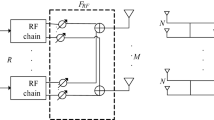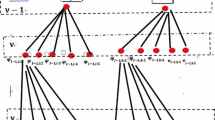Abstract
The problem of multiple access interference (MAI) and inter-symbol interference (ISI) suppression in direct-sequence ultra-wideband (DS-UWB) systems is considered. This paper is dedicated to the application of intelligence computational techniques based on bionics to solve the difficult issue of multiuser detection (MUD) design capable of canceling the so-called MAI to reach low bit error rate (BER) with acceptable computation complexity. We apply the stochastic algorithm that employs a Hopfield neural network (HNN) and particle swarm optimization (PSO) for the MUD problem in DS-UWB system. The use of the HNN embedded PSO (HNNPSO) technique for multiuser detection is a novel ideal, and it leads to efficient techniques that can find a satisfactory solution by maximizing likelihood (ML) function in a small number of iterations. The computer experiments showed that the proposed HNNPSO technique not only can find optimal or close-to-optimal solutions but also obtain both better and more robust results than the existing algorithm reported recently in this literature.
Similar content being viewed by others
References
Win, M. Z., & Scholtz, R. A. (1998). Impulse radio: How it works. IEEE Communications Letters, 2, 36–38.
Yang, L., & Giannakis, G. B. (2004). Ultra-wideband communications an idea whose time has come. IEEE Signal Processing Magazine, 21, 26–54.
Yang, L., & Giannakis, G. B. (2005). A general model and SINR analysis of low duty-cycle UWB access through multipath with narrowband interference and rake reception. IEEE Transactions on Wireless Communications, 4, 1818–1833.
Guvenc, I., & Arslan, H. (2007). A review on multiple access interference cancellation and avoidance for IR-UWB. Signal Processing, 87, 623–653.
Verdú, S. (1998). Multiuser detection. Cambridge: Cambridge University Press.
Verdú, S. (1986). Minimum probability of error for asynchronous Gaussian multiple-access channels. IEEE Transactions on Information Theory, 32, 85–96.
Li, Q., & Rusch, L. A. (2002). Multiuser detection for DS-CDMA UWB in the home environment. IEEE Journal on Selected Areas in Communications, 20, 1701–1711.
Foerster, J. R. (2002). The performance of a direct-sequence spread ultra wide-band system in the presence of multipath, narrowband interference, and multiuser interference, in digest of papers. In IEEE conf. ultra wideband syst. technologies, May 2002 (pp. 87–91).
Liu, R., & Elmirghani, J. (2007). Performance of impulse radio direct sequence ultra-wideband system with variable-length spreading sequences. IET Communications, 1, 597–603.
Yoon, Y. C., & Kohno, R. (2002). Optimum multiuser detection in Ultra wide-band multiple-access communication systems. In Proc IEEE international confer on commun., New York City, NY (pp. 812–816).
Zhang, Y., Lu, W.-S., & Gulliver, T. A. (2005). Recursive multiuser detection for DS-UWB systems. In IEEE communications, computers and signal processing, Aug. 2005 (pp. 534–537).
Lin, L., & Wang, A. (2008). New hybrid multiuser receiver for DS-UWB system. In IEEE wireless communications, networking and mobile computing, Oct. 2008 (pp. 1–5).
Tan, T.-H., Huang, Y.-F., Lin, C.-W., & Fu, R.-H. (2006). Performance improvement of multiuser detection using a genetic algorithm in DS-CDMA UWB systems over an extreme NLOS multipath channel. In Proc. of IEEE SMC, Taipei, Taiwan, Oct. 2008, vol. 3 (pp. 1945–1950).
Chen, H. H., Mohsen, G., Tsai, C. H., Yang, X., Romano, F., & Sharif, H. R. (2007). Pulse waveform Dependent BER analysis of a DS-CDMA UWB radio under multiple access and multipath interference. IEEE Transactions on Wireless Communications 6, 2338–2347.
Fogle, D. B. (2000). Evolutionary computation: toward a new philosophy of machine intelligence, 2nd edn. Piscatewy, IEEE Press.
Kennedy, J., & Eberhart, R. C. (1995). Particle swarm optimization. In Proc IEEE international conf on neural networks, Perth, Australis (pp. 1942–1947).
Binbin, X., Jianping, A., Ronghua, Z., & Aihua, W. (2008). Turbo multiuser detection for STBC MC-CDMA uplink systems using hybrid particle swarm optimization algorithm. In Third international conference on communications and networking (pp. 987–991).
Long, Y.-f., Zhao, Z.-j., & Shen, L. (2009). A multiuser detection for MC-CDMA system based on particle swarm optimization algorithm with Hopfield neural network. International Conference on Communications and Mobile Computing, 1, 283–286.
Soujeri, E., & Bilgekul, H. (2002). Hopfield multiuser detection of asynchronous MC-CDMA signals in multipath fading channels. IEEE Communications Letters, 6, 147–149.
Ratnaweera, A., Halgamuge, S. K., & Watson, H. C. (2004). Self-organizing hierarchical particle swarm optimizer with time-varying acceleration coefficients. IEEE Transactions on Evolutionary Computation, 8, 240–255.
Robinson, J., & Rahmat-Samii, Y. (2004). Particle swarm optimization in electromagnetic. IEEE Transactions on Antennas and Propagation, 52, 397–407.
Janson, S., & Middendrof, M. (2005). A hierarchical particle swarm optimizer and its adaptive variant. IEEE Transactions on Systems, Man and Cybernetics. Part A. Systems and Humans, 35, 1272–1282.
Hung, H.-L., & Wen, J.-H. (2009). Blind multiuser detection in frequency domain for MC-CDMA systems using particle swarm optimization. Wireless Personal Communications, 54, 447–466.
Hung, H.-L., Wen, J.-H., Lee, S.-H., & Huang, Y.-F. (2009). Performance analysis of PSO-based parallel interference canceller for MC-CDMA communication systems. European Transactions on Telecommunications, 20, 287–297.
Soo, K. K., Siu, Y. M., Chan, W. S., Yang, L., & Chen, R. S. (2007). Particle swarm optimization based multiuser detector for CDMA communication. IEEE Transactions on Vehicular Technology, 56, 3006–3013.
Liu, H., & Li, J. (2008). A particle swarm optimization-based multiuser detection for receive-diversity-aided STBC systems. IEEE Signal Processing Letters, 15, 29–32.
Saleh, A. A., & Valenzuela, R. A. (1987). A statically model for indoor multipath propagation. IEEE Journal on Selected Areas in Communications, 5, 128–137.
Hopfield, J. J. (1982). Neural networks and physical systems with emergent collective computational abilities. Proceedings of the National Academy of Sciences, 79, 2554–2558.
Proakis, J. G. (1995). Digital communications (3rd edn.). New York: Mc-Graw Hill.
Wen, J.-H., Lee, S.-H., Huang, Y.-F., & Hung, H.-L. (2008). A sub-optimal PTS algorithm based on particle swarm optimization technique for PAPR reduction in OFDM systems. EURASIP J. Wireless Commun. Network., 2008, 1–8.
Author information
Authors and Affiliations
Corresponding author
Rights and permissions
About this article
Cite this article
Hung, HL. Interference cancellation for HNNPSO multiuser detection of UWB systems over multipath fading channel. Telecommun Syst 52, 1191–1203 (2013). https://doi.org/10.1007/s11235-011-9634-x
Published:
Issue Date:
DOI: https://doi.org/10.1007/s11235-011-9634-x




